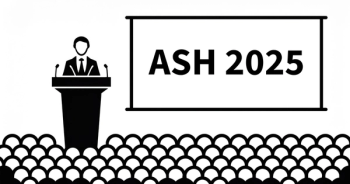
Peers & Perspectives in Oncology
- February 2025
- Pages: 78
Gasparetto Explains Rationale for Quadruplet Front Line in Transplant-Ineligible Myeloma

In a Community Case Forum in partnership with the North Carolina Oncology Association, Cristina Gasparetto, MD, discussed the CEPHEUS, IMROZ, and BENEFIT trials of treatment for transplant-ineligible newly diagnosed multiple myeloma.
CASE SUMMARY
- The patient is a man aged 79 years with a medical history of hypertension controlled with lisinopril.
- He presented to his physician with complaints of back pain, fatigue, and occasional but recurring dizziness, nausea, and constipation.
- ECOG performance status: 1
- PET/CT imaging showed multiple bone lesions in vertebrae without extramedullary disease.
- Diagnosed with Revised International Staging System stage II/ R2-ISS stage III IgG-κ multiple myeloma
- During the consultation, the patient stated that he is the caregiver for his wife, who has chronic rheumatoid arthritis.
- After discussion, it was determined that it would not be feasible for him to receive an autologous stem cell transplant.
- Isa-VRd (isatuximab [Sarclisa], bortezomib [Velcade], lenalidomide [Revlimid], dexamethasone) induction therapy was initiated.
- He achieved very good partial response post induction therapy.
is the goal of quadruplet trials in the transplant-ineligible setting?
GASPARETTO: [The trials are asking], can we improve on the MAIA trial [NCT02252172] regimen [of daratumumab (Darzalex), lenalidomide, and dexamethasone]? Can we use the same concept that we use in the transplant-eligible setting in the non–transplant-eligible [setting]? The CEPHEUS trial [NCT03652064]…was designed specifically for nontransplant patients [but included] a fair amount of patients who were younger who were transplant deferred. They were not all patients who were not eligible for transplant. In this study, frail patients were excluded. The upper age limit was 80 years; if you look at the median age in both arms, it was approximately 70 years. The number of patients younger than 65 was approximately 18%, and the majority were 65 to 70. You had a fair number of patients above age 70, but patients above age 80 were excluded, and the frail patients, if you look at the ECOG performance status, were a very low number of ECOG 2. So, the majority were patients who were fit [and the rest] had intermediate fitness. They were not frail patients, and 26% were transplant deferred, so they were eligible for transplant, but they decided not to go to transplant.1
The primary end point of the study was minimal residual disease [MRD] negativity, which translates to a better outcome, but progression-free survival [PFS] was a secondary end point. When we look at the MRD, which was improved with the addition of daratumumab, we have almost 61% vs 39% with triplet [VRd]. Going back to the schema, patients receive bortezomib for the first 8 cycles, then they both drop the bortezomib. The VRd arm remains on lenalidomide/ dexamethasone, and the Dara-VRd arm proceeds to daratumumab, lenalidomide, and dexamethasone.
The overall response rates are similar. The depth of the response is striking; we have 81.2% with complete remission or better with Dara-VRd vs 61.6% with VRd. There is no doubt that the addition of the daratumumab improved the depth of the response.
In terms of tolerability, are we adding some more toxicity with the daratumumab? We are always concerned about the neutropenia, and it was not [much more]. It was a little bit more neutropenia and more myelosuppression with the addition of the daratumumab. If you look at the grade 3 or 4 neutropenia, it was 44.2% for Dara-VRd vs 29.7% for VRd. We have some gastrointestinal [adverse events (AEs) that] were similar. Upper respiratory tract infection was also similar between the 2 arms. There were more COVID-19 infections [38.1% with Dara-VRd vs 24.6% with VRd], and then the rate of secondary primary malignancy was also similar. So, there was more neutropenia but not much other increased toxicity with the addition of daratumumab.
What is the significance of the IMROZ study (NCT03319667), and how does it compare to CEPHEUS?
This combination was not chosen with this patient [because] it is not FDA approved [in the transplant-ineligible setting], but we do have another anti- CD38 antibody, isatuximab, that is now approved in combination with the VRd triplet. The IMROZ study was a phase 3 trial of quadruplet vs triplet in transplant-ineligible [patients], and again, we see the bortezomib during the induction therapy, and then the bortezomib drops off, and then the patients continue isatuximab, lenalidomide, and dexamethasone vs lenalidomide/ dexamethasone.
The primary end point of this study was PFS. In this study, the bortezomib is still given twice a week. The PFS was the primary end point, and the 2 curves start to detach at approximately 6 months. The medium PFS at 60 months is not reached for the quadruplet; for the triplet, it was 54.34 months [HR, 0.596; 98.5% CI, 0.406-0.876; log-rank P = .0005]. The 60-month [PFS rate] was 63% with Isa-VRd vs 45% with VRd.2
Again, we have the bortezomib earlier on in both arms and then after dropping the bortezomib, we start to see the benefit of the addition of isatuximab…. In terms of overall response, they were similar, but you see more of the deeper responses with the addition of isatuximab [Figure2].
In terms of toxicity, like we saw with the prior studies, they were similar. The addition of isatuximab didn’t contribute to additional toxicity in this study. The rate of grade 3 or higher AEs was very comparable between the 2 arms [91.6% for Isa-VRd vs 84.0% for VRd]. We have the neutropenia, where grade 3 or higher was 54% vs 37% [respectively] like we saw in the [CEPHEUS] trial. There was a bit more COVID-19 in this study; the pneumonia of grade 3 or higher was 20% vs 12%, respectively, so that was expected. We knew that we were going to have more infection with the myelosuppression and compromised immune systems. We learned very quickly that we have to support aggressively these patients [and] put them on antibiotic prophylaxis and intravenous immunoglobulin supplementation.
The PFS was the primary end point of the study, and very importantly, in this study, the upper age was 80, like the prior studies. Some of the frail patients were included [n = 129], so we have more frail patients [than CEPHEUS]. If we believe age means frailty, we think a 79-year-old is a frail patient.… They analyzed this frailer population of patients because the question that we had before is, “Are the frail and older patients going to be able to tolerate the bortezomib?” And the data were similar. If you look at the PFS in the frail subgroup, it was again not reached at time of the follow-up vs 37.5 months in the triplet [HR, 0.584; 95% CI, 0.340-1.004; P = .0516]. To give you a comparison with the nonfrail subgroup, [the HR was 0.593; 95% CI, 0.403-0.873; P = .0080].3
In terms of MRD negativity, we see an improvement even in this [frail] population of patients compared with the triplet [50.7% vs 22.8%, respectively; P = .0012]. So, there is no doubt that the addition of the isatuximab was beneficial even in the older, more frail population. The upper age was still 80 [although] the patient population was a little bit different in IMROZ [compared with CEPHEUS]. There were no transplant-deferred patients [in IMROZ]. They were all not transplant eligible.
In terms of safety, even in this [frail] subpopulation of patients, [for which this trial] was criticized because the bortezomib was delivered twice a week, we don’t see major differences in the toxicity. If you look at the neutropenia, it was higher [grade 3 or higher, 38.89% vs 15.79%]. The risk of pneumonia was 25% vs 21%, and COVID-19 [pneumonia] was higher in this population of patients during the pandemic, 9% vs 1.7%. So, even in this population of patients, the addition of the isatuximab didn’t cause a striking difference in the safety profile.
Considering the added cost of this regimen, is there overall survival (OS) benefit to the quadruplet?
There are some early signals…. [However], we can keep patients with myeloma alive longer. In these patients with standard-risk myeloma, we’re doing so well in the relapsed setting, and that’s the reason the OS is a tough one [to assess] because now you’re comparing the 2 groups, and some of these patients proceeded with salvage therapy, and we’re pretty good at keeping them alive, but the big deal is that you lose patients through the lines of therapy.
Let’s say this patient started Isa-VRd. He stopped the bortezomib and is now on isatuximab and lenalidomide. He has a pretty good quality of life. When you restart therapy at time of progression, you are getting more complex. Now, you’re going to have a more cumbersome [second-line] regimen if you think this patient is refractory to the anti-CD38 antibody and lenalidomide.
The MAMMOTH study was an eye-opener because we knew the patients in the relapsed setting were doing poorly. But in the MAMMOTH study, we saw that the patients there were refractory to daratumumab, an anti-CD38 antibody, leaving nothing. The best overall survival was 9.3 months, with the worst being 1.5 months.4 So, this population failing after an anti-CD38 antibody makes your OS short. So, you’re telling this patient, “I’m going to treat you [suboptimally] because then I have other things to rescue you.” It’s not necessarily going to be the case. You may not be able to deliver; they may have a more resistant myeloma, so you want to put all your money up front. We have learned that we have to go out of the gate strong because we lose patients, the myeloma goes to clonal evolution resistance…and we have difficulties sustaining some of these chimeric antigen receptor T-cell patients.… I would try to achieve MRD negativity and sustain that and maintain their quality of life, even if I spend more money.
The important thing is that now, with the proteasome inhibitor, you’re comparing the MAIA regimen to the quadruplet. Now we have the benefit of the proteasome inhibitor…. Also, that population of high-risk patients didn’t perform well in the MAIA trial. However, even in the standard-risk [population], you see an improvement [with quadruplet].
How did the approach of the phase 3 BENEFIT/IFM2020-05 trial (NCT04751877) differ from other quadruplet studies?
The BENEFIT trial is the more informative trial to me. The BENEFIT trial is not a registrational trial. It’s an investigator-initiated trial, and that’s the reason the bortezomib was given once a week, like we do it in the community, and it better fits this population of patients because we all [do not] use…bortezomib twice a week. If you want to debulk the myeloma very quickly, you do a couple of cycles [twice weekly], and then you go back.
The BENEFIT trial was designed to compare the quadruplet [Isa-VRd] with isatuximab, lenalidomide, and dexamethasone, [which] is like the MAIA trial [regimen]. [If] you’re using the MAIA regimen, here is a study that shows you the quadruplet vs [a regimen] similar to the MAIA [regimen with] a different CD38 antibody. You have isatuximab, lenalidomide, and dexamethasone, [with or without] the addition of bortezomib once a week.
Now, we see the bortezomib going initially to a weekly induction. There is VRd, and then there is a continuation of the induction cycles 13 to 18. The dexamethasone is dropped, and then patients continue isatuximab and lenalidomide with the dropping of the bortezomib, vs the triplet without the bortezomib: isatuximab, lenalidomide, dexamethasone. Then there is a drop of the dexamethasone, which, if anything, is one of the worst drugs for this population of patients. Then the patients continue isatuximab/lenalidomide until progression.
The MRD was the primary end point. [Compared with a regimen similar to] the MAIA standard of care at 18 months, at 10–5 [sensitivity], we have 53% [MRD negativity for Isa-VRd] vs 28% [for Isa-Rd (OR, 3.16; 95% CI, 1.89-5.28; P < .0001)]. That was the primary end point of the study. With the addition of the bortezomib to the isatuximab, lenalidomide, [and] dexamethasone, you improve the depth of the response, going from 53% vs 28% [at] 10–6, and 38% vs 17% [at 10–6].5
We want to see the durability of the MRD. One time [at 12 months] is not enough because all the critique of MRD [is related to] the sustainability. We reach a deeper response. We deliver less bortezomib and then the dexamethasone is withdrawn, and this is a comparison with MAIA, which is the same kind of clinical trial. So if I’m 79 and I come to your clinic, would you give me the [daratumumab, lenalidomide, and dexamethasone] vs [quadruplet] if I’m an educated patient reading the literature, and I want you to give me the best single [line of therapy]?
Could these patients receiving multiple antimyeloma agents be treated with less or no dexamethasone?
There are trials like that where there is de-escalation of dexamethasone. We know that at the 2023 American Society of Hematology Annual Meeting, one of the big deals was the de-escalation of some of these drugs, which I think is very important.6 We have the big [phase 3] study from Italy [NCT02215980] comparing the continuation with the dexamethasone vs the lenalidomide alone, showing no difference in this population of patients.7 We know that we don’t need so much dexamethasone. Nevertheless, when you see these data, and now you have a 79-year-old in relatively good performance status, it’s difficult to say, “I’m going to give you the triplet.”
In terms of toxicity [in BENEFIT], we see the rate of grade 3 or more [AEs] was very comparable [69% for Isa-VRd vs 67% for VRd]. The bortezomib didn’t add much, and even the AE rate for patients was a little bit higher on the [Isa-VRd arm] because they were able to sustain therapy longer.5
We still see the neutropenia, which was comparable at grade 3 or 4 at 40% for Isa-VRd vs 45% for Isa-Rd. [We saw] the same kind of gastrointestinal [AEs], rash, muscle spasms with dexamethasone, the eye disorders with the dexamethasone, and secondary primary malignancy rate was the same. For infection, we see 36% grade 2 or more with Isa-VRd vs 28% with Isa-Rd. The peripheral neuropathy was the worst. That’s the problem [related to bortezomib]. It was 27% grade 2 or more [with Isa-VRd vs 10% with Isa-Rd].
REFERENCES
1. Usmani SZ, Facon T, Hungria V, et al. Daratumumab + bortezomib/lenalidomide/dexamethasone in patients with transplant-ineligible or transplant-deferred newly diagnosed multiple myeloma: results of the phase 3 CEPHEUS study. Clin Lymphoma Myeloma Leuk. 2024;24(suppl 2):S288-S289. doi:10.1016/S2152-2650(24)02344-9
2. Facon T, Dimopoulos MA, Leleu XP, et al. Phase 3 study results of isatuximab, bortezomib, lenalidomide, and dexamethasone (Isa-VRd) versus VRd for transplant-ineligible patients with newly diagnosed multiple myeloma (IMROZ). J Clin Oncol. 2024;42(suppl 16):7500. doi:10.1200/JCO.2024.42.16_suppl.7500
3. Manier S, Dimopoulos MA, Leleu XP, et al. Isatuximab, plus bortezomib, lenalidomide, and dexamethasone (VRd) for newly diagnosed multiple myeloma (NDMM) transplant-ineligible patients: frailty subgroup analysis of IMROZ. Clin Lymphoma Myeloma Leuk. 2024;24(suppl 2):S290-S291. doi:10.1016/S2152-2650(24)02347-4
4. Gandhi UH, Cornell RF, Lakshman A, et al. Outcomes of patients with multiple myeloma refractory to CD38-targeted monoclonal antibody therapy. Leukemia. 2019;33(9):2266-2275. doi:10.1038/s41375-019-0435-7
5. Leleu XP, Hulin C, Lambert J, et al. Phase 3 randomized study of isatuximab (Isa) plus lenalidomide and dexamethasone (Rd) with bortezomib versus IsaRd in patients with newly diagnosed transplant ineligible multiple myeloma (NDMM TI). J Clin Oncol. 2024;42(suppl 16):7501. doi:10.1200/JCO.2024.42.16_suppl.7501
6. Banerjee R, Sexton R, Cowan AJ, et al. Impact of dexamethasone (dex) dose strength on outcomes in newly diagnosed multiple myeloma (NDMM): a secondary analysis of SWOG studies S0777 and S1211. Blood. 2023;142(suppl 1):1066. doi:10.1182/blood-2023-181744
7. Larocca A, Bonello F, Gaidano G, et al. Dose/schedule-adjusted Rd-R vs continuous Rd for elderly, intermediate-fit patients with newly diagnosed multiple myeloma. Blood. 2021;137(22):3027-3036. doi:10.1182/blood.2020009507
Articles in this issue
10 months ago
Roundtable Roundup: Bladder Cancer







































